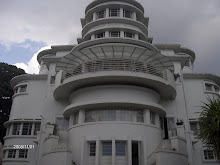Name : Supartini
Stud.Number : 0807337
Class : 3B
Periods of English Literature
Literature is the art of written works. Literally translated, the word means "acquaintance with letters" (from Latin littera letter), and therefore the academic study of literature is known as Letters (as in the phrase "Arts and Letters"), from wikipedia, the free encyclopedia. Etymologycally, the Latin works “literatura” is come from “littera”, which is the smallest element of the alphabetical writing.
As an international language, English is a very global and important language so every English literature works will spread globally and can be studied by the people all around the world. In general people mostly only know some famous English writer such as William Shakespeare, T.S. Elliot, William Wordsworth, etc. that had wrote lots of the amazing written works. People in the world knew that the English literature is one of the world’s heritages.
Just like any other literature, the English literature also has the periods based on the time or era; here are some explanations about the periods of the English literature:
1. The old English Period or the Anglo-Saxon Period (5th until 11th century)
This period is the first period in the English Literature that began from the invasion of the Britain by the Germanic (Anglo-Saxon) tribes in the 5th century until the French invasion under William the Conqureor in 1066. Earliest texts written at this time period are called Old English or “Anglo-Saxon.”. Here are some examples of the Old English or Anglo Saxon written works:
• Anonymous magic charms, riddles, and poems: “The Seafarer” (9th century), and “The Wanderer” (9th-10th century)
• Epic works: “the mythological Beowulf” (8thcentury) and ”The Battle of Maldon” that based on the real facts.
2. The Middle English Period (12th until 15th century)
This period began when England was conquered by the French-speaking Normans in the 11th century the culture adapted and changed a step forward. The various literary products are combined. The example of written works that written in this period are:
• Lyric poetry and epic long poems with religious contents: “Piers Plowman” (1367-1370) by William Langdan.
• The romance: “Sir Gawain and the Green Knight” (14th century) and “Le Morte d’Arthur” by Thomas malory.
• Narratives: “Conterburry Tales” by Geoffrey Chaucer and “Il Decamerone” by Giovanni Boccacio.
3. The English Renaissance or the early new English Period (16th until 17th century)
The English Renaissance period term focuses on the history of the language and the Elizabethan Age (Queen Elizabeth I) or Jacobean Age (King James) that based on the political rule. The works examples are:
• Epic: “Faere Queene” (1590-1595) by Edmund Spenser.
• Drama by William Shakespeare and Christopher Marlowe.
• Independent prose genres: Romance “Euphues” by Lyly and “Arcadia” by Philip Sydney.
• Drama: “Court Masque”
4. The Eighteenth Century period/ the Neoclassical Golden of Augustan Age (18th century)
This period is commonly regarded as an independent epoch because the classical literary and the literary theory were adapted to the suit contemporary culture.
The works examples:
• Translations
• Theoretical essays
• Literary texts
• The novels: “Robinson Crusoe” by Daniel Defoe, “Pamela” by Samuel Richardson, “Tom Jones” by Henry Fielding, and “Tristram Shandy” by Laurence Sterne.
5. The Puritan or Colonial Age (17th until 18th century)
This period can be seen as the first literary phenomenon on the North American continent.
The famous writer examples in this period are: Cotton Mather, John Withrop, and Phillips Wheatleys.
6. The Romanticism (first half of 19th century)
This era marks the beginning a new period at the end of 18th century. This period commonly use the author’s personal feeling in their written works and finally produce the romantic writings. Here are some works examples:
• “The Lyrical Balads” by Wiliam Wordsworth and Taylor Coleridge.
7. The Realism and Naturalism (Second half of 19th century)
This period described as the movement which tries rto truthfully describe “reality” through language.
8. The Modernism period (first to second world war)
The Modernism period can be seen as the reaction to the Realist movements of the late nineteenth century. “Modernism” is a blanket term which encompasses the extensive which manifest themselves.
The main works:
• “Ulysses” and “Vinegan Walks” by Joyce.
• “Mrs Dalloway” and “To the Light House by Virginia Woolf, “The Cantos” , “The Waste Land”, and “T.S. Elliot” by Ezra Pounds.
• And “The Sound and the Fury” by William Flaukner.
9. The Postmodernism period (1960s-1970s)
This literary movement of the second half of the 20th century indirectly deals with Nazi crimes and the nuclear destruction of World War II.
The works examples:
• “Lost in the Funhouse” by John Barths.
• “The Crying of Lot 49” by Thomas Pynchon.
• “Double or Nothing” by Raymond Federman.
Jumat, 02 Oktober 2009
Langganan:
Posting Komentar (Atom)


Tidak ada komentar:
Posting Komentar